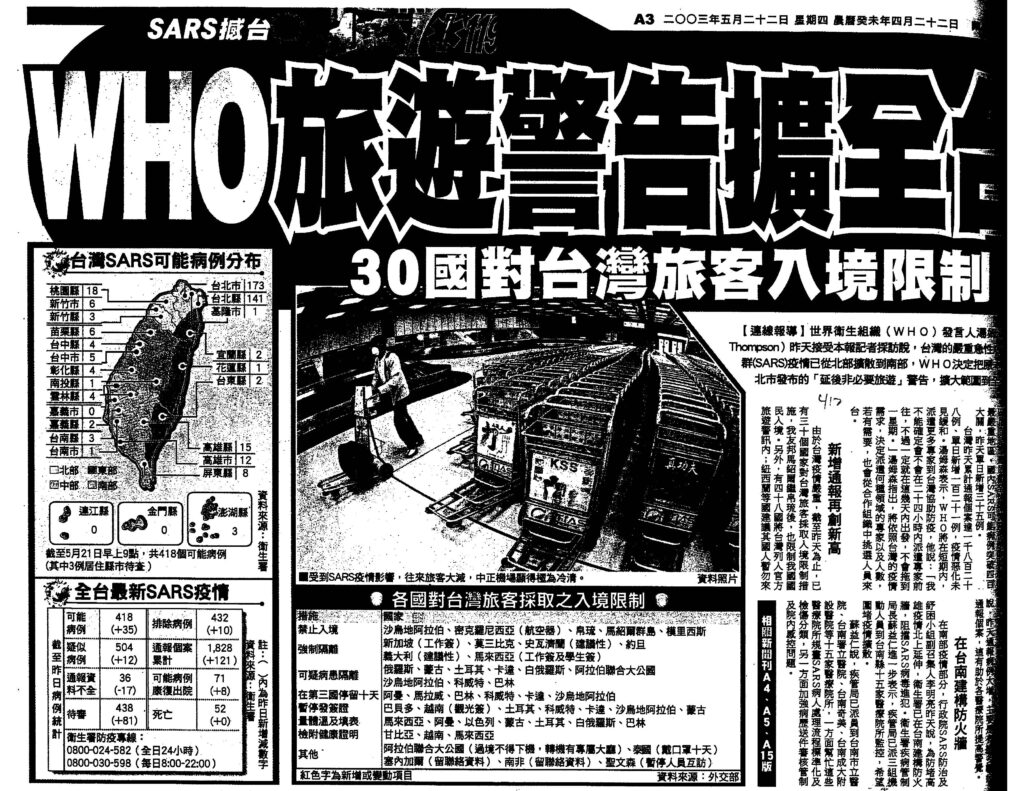Photo: Front page of the Apple Daily News: May 22, 2003
The recent coronavirus outbreak in Wuhan, China has stoked fears of a global pandemic. China has implemented a quarantine and other governments have restricted travel. Authorities have prevented passengers on several cruise ships from disembarking in the hope of preventing transmission.
Novel outbreaks like the Wuhan coronavirus occur regularly throughout the world. Previous examples include the 2013-2015 outbreak of Ebola in West Africa, several outbreaks of Swine Flu in South Asia in the past decade, and the 1918 Spanish flu, which killed around 50 million people (more than the war preceding it). The Wuhan virus is a cousin of the 2003 SARS virus, which caused 8,000 infections and 774 deaths throughout East Asia in 2002 and 2003.
In a novel epidemic, the public must assess and decide how aggressively to avoid a new risk. People are familiar with the threats posed by perennial health risks like heart attacks and traffic accidents. In a novel outbreak, it is unclear how the disease is transmitted, how severe the symptoms are, and what prevention strategies are most effective.
Lacking clear information, people must decide whether to travel, wear a face mask, or keep a medical appointment. How do we formulate a response without understanding the nature of the threat?
Together with Anup Malani (University of Chicago) and Chun-Fang Chiang (National Taiwan University), I studied this question in the context of the SARS epidemic in Taiwan.
Since some early infections occurred in hospitals, the public strongly associated health care visits with SARS risk. In fact, the individual risk of SARS was quite small. With just 312 confirmed infections in Taiwan, the prevalence was 0.001 percent. Nonetheless the outbreak triggered a 31 percent decline in outpatient health care visits over several weeks in the spring of 2003.
Where did this outsized response originate? In the paper we hypothesize that in the absence of reliable public information, people learn from the actions of their peers. If everyone else is avoiding health facilities, it must mean that these places are dangerous. This phenomenon could lead to “herding”, in which these responses reinforce each other. By avoiding the clinic, one person sends a signal to her peer that the clinic is risky. This peer may avoid the clinic as well, compounding the signal to others. Within a short time, the public could respond to a small risk in an exaggerated way. (Alternatively, herding might mitigate the public reaction to a threat if people received signals from peers that the threat was small.)
To investigate this hypothesis, we used comprehensive health care data for 1 million people to study the correlation between the visit patterns of people attending common medical facilities. We found strong evidence that people curtailed their visits more during the SARS outbreak if their peers did the same.
Since this pattern could occur for several reasons, we then distinguished between longtime community residents (who were more socially connected) and people who had arrived recently. Consistent with learning, we found an especially strong correlation for the longtime residents. We estimate that the peer effect was half as large as the response to official announcements of the number of SARS cases nationwide. This peer effect could explain about one quarter of the decline in health care visits during the SARS outbreak.
What was the cost of all those foregone visits? An examination of mortality data show that the epidemic coincided with 520 additional non-SARS deaths, which was over six times the number of deaths from SARS itself.
The SARS epidemic disappeared on its own in the fall of 2003. Fewer patients in health facilities throughout Taiwan may have helped to limit SARS transmission, although it is difficult to know for sure.
While we focus on health care visits, we may expect similar phenomena with other risk avoidance behaviors. After the 9/11 terrorist attacks, many people chose to drive instead of fly, leading to several thousand excess traffic fatalities. The 2011 tsunami in Fukushima, Japan forced people to assess the risk of radiation from local seafood. Despite reassuring test results, consumption of Japanese seafood fell dramatically.
Current reactions to the Wuhan coronavirus may also be based in part on a reaction to an unfamiliar risk. The policy lesson is to communicate clearly while preserving credibility. People look to peers when credible information is missing. Policymakers can quell public fears by providing timely and accurate information.
Learn more about Daniel Bennett’s work on his website.
